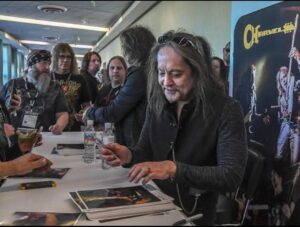Rock guitar icon Jake E. Lee, best known for his blistering solos on Ozzy Osbourne’s Bark at the Moon and The Ultimate Sin, has candidly shared the physical toll of arthritis on his playing, describing it as a painful journey that’s required him to essentially “relearn” how to wield his instrument. In a heartfelt interview, the 68-year-old musician revealed the extent of his struggles, admitting that the condition has left his joints “bone on bone,” robbing him of sensation and forcing adaptations to continue his lifelong passion.
“I can’t feel it. It’s bone on bone, even when I held my guitar it was…,” Lee said in the emotional discussion, his voice trailing off as he recounted the numbness and discomfort that now accompany every note. The arthritis, primarily affecting his right wrist and left hand, has been a persistent challenge, exacerbated by a traumatic shooting incident last year that damaged his left arm. Despite these hurdles, Lee remains defiant, emphasizing that performing isn’t about perfection anymore but pain management and perseverance.
The revelation comes amid Lee’s recent high-profile appearances, including a poignant reunion with Osbourne at the star-studded Back to the Beginning concert in July, which served as Black Sabbath’s farewell and Osbourne’s final performance. There, Lee battled through his limitations to honor his former bandmate, though he expressed doubts about tackling demanding tracks like “Bark at the Moon” due to the physical strain. “Right now, with my wrist, the arthritis and everything, that would be very challenging,” he told Guitar World ahead of the event. Ultimately, he opted for selections that played to his adjusted strengths, showcasing his resilience in front of a global audience.
To cope, Lee has made practical changes to his setup, switching to lighter guitar picks and strings to ease the pressure on his hands. “I usually use a heavy pick, but I went to a lighter one,” he explained. “It forced me to have a lighter touch with my right hand, and that’s been interesting.” This shift has not only helped manage the pain but has unexpectedly reignited his creativity, turning the ordeal into a “fun” reinvention of his style. “I’ve had to adjust my style. In a way, it’s like learning to play guitar again,” Lee reflected, highlighting how the condition has limited tougher riffs but opened doors to new techniques.
Lee’s story resonates deeply in the rock community, where aging musicians like Rush’s Alex Lifeson have similarly discussed arthritis’s creeping impact. For Lee, who stepped away from the spotlight for years after his time with Badlands and a personal hiatus, this battle underscores his enduring commitment to music. Shot multiple times in a random attack that left him reflecting on a “darker, more dangerous” world, Lee has since focused on recovery, crediting treatments that avoided radical surgery for allowing him to play again after a four-to-five-year lull.
Fans have rallied around the guitar hero, whose signature sound defined ’80s metal and influenced generations. As Lee eyes potential tours, his openness about these struggles serves as an inspiring reminder that true legends adapt and endure. “The aches and pains of ageing are unavoidable – but that doesn’t mean you have to quit performing,” he affirmed, proving that even bone-on-bone, the fire of rock ‘n’ roll burns on.
